|
Dave Harris [Originally published just after ATP. Before reading this, I also read a more general commentary on Bacon: Davies, H and Yard S. Francis Bacon. London: Abbeville Press. That book mentions a series of interviews between Bacon and Sylvester (and others), which Deleuze also cites (rather heavily) I did not make notes, but, obviously, Bacon's own comments on his work are not the same as Deleuze's interpretations, which raises problems for the boring old empirical validity of what Deleuze says -- sometimes Bacon's views can be taken as supportive 'evidence', but at other times they need to be reinterpreted. Deleuze also draws heavily (!) on Gowing's essay on Cézanne., and the book also contains extracts from the important observations of, and remarks and aphorisms by, Cézanne himself in Vollard or Bernard. I am otherwise entirely in the hands of Deleuze. Finally, idly browsing D Hockney's (2006) Secret Knowledge. London: Thames and Hudson, I was reminded of how important the actual technology of the arts is. Hockney argues for the relevance of new optical devices in painting 'realistically', and I also recall arguments about the role of the German chemical industry in producing consistent colours in oil paint. No technical issues are discussed in Deleuze, neither here nor in the huge books on the cinema, which limits his critique of 'human creativity' a bit.] Authors Foreword The idea is to consider aspects of Bacon's paintings moving from the simplest to the most complex, informed by 'the viewpoint of the general logic of sensation' (xi). All the aspects 'coexist in reality. The converge in colour, in the "colouring sensation", which is the summit of this logic'. There are also implications for the history of painting Author's Preface to the English edition Bacon's paintings are violent, not only the depictions of horror or mutilations, but rather of violence 'that is involved only with colour and line: the violence of a sensation' (xii), something static or potential, a reaction or expression, like a 'scream rent from us by a foreboding of invisible forces' [luvvie]. Bacon wants to paint the scream. The bodies should be seen as ordinary ones 'in ordinary situations of constraint and discomfort'. He wants to show 'the invisible forces that model flesh', especially the inertia of flesh itself, falling from bones or flattening bodies. It is the effects of movement on the mobile bodies and interior forces that he is depicting, informed by 'an intense pity: pity for the flesh'. There are also large fields of colour detached from Figures, with no depth, sometimes divided into sections or frames and tubes, 'an armature, a bone structure' (xiii). [NB Figure with a capital F denotes a special meaning, avoiding confusion with ordinary human figures?]. Background and Figure are related, sometimes the fields of colour offer a shallow depth or hollow volume in which the Figure 'enacts its small feats', rather like experimental theatre or Beckett novels. As the fields of colour press in, the Figure presses outward, trying to pass through the fields in spasms or screams. We see this in objects like umbrellas which mask parts of the Figure [and seem to act like a kind of funnel to help the body escape]. The scrubbed and blurred effects indicate the 'dissipation' of the Figures. Sometimes the Figure disappears altogether leaving a jet of water or dust, characteristic of Bacon's individual abstractions. Colour is very important and there are two different systems one relating to the Figure and the other to the field. We might see this as an extension of Cézanne [pass, for now at least] leading to 2 further problems how to preserve the unity of the background as a 'perpendicular armature for chromatic progression' while preserving the specificity of a form 'in perpetual variation' (xiv). This was a problem common to Van Gogh and Gauguin, making sure the ground did not become inert nor the form 'murky'. Both made the background into 'vast monochrome fields that are carried towards infinity' and invented new colours for the flesh, making it look rather ceramic, kiln-fired. Experiments with monochrome fields have continued, varying not hue but rather 'subtle shift of intensity or saturation determined by zones of proximity'. This is Bacon's route, inducing zones of proximity by sections or by a band or stripe crossing the field. Bacon also produces broken tones for flesh, 'as though baked in a furnace and flayed by fire'. So both problems are addressed at the same time, unlike most other painters, and there is correlation between them: 'a brilliant, pure tone for the large fields, coupled with a program of intensification: broken tones for the flesh, coupled with the procedure of rupturing… a critical mixture of complementaries'. In this way, painting conquers time [luvvie again] — through colour, referring to 'eternity and light in the infinity of a field', and through 'metabolic variability in the enactment of… bodies'. There are parallels with Messiaen's music. Most modern painting has abandoned simple figuration, but Bacon breaks with it in a different way, not drawing on impressionism, expressionism, symbolism, cubism or abstraction. Instead, the Figure is elevated to prominence and related to the field. This rejects all narrative and all symbolization, forms which result only in 'the bogus violence of the represented or the signified' (xv). [I bet actual viewers restore both. T Chevalier has written a novel The Girl in the Pearl Earring. In the Times she says how she viewed the painting:
Can you do that with Bacon's paintings? Do viewers still speculate about the relationships Bacon had with his subjects in the portraits? Did he pose them with screams or smiles? I f we know G Dyer was also his lover does that make a difference?] What is missing is 'the violence of sensation — in other words, of the act of painting'. Bacon's revival of the triptych offers separate and distinct sections which also negate narratives. Yet they are linked with a 'kind of brutal unifying distribution' that denies any symbolic undertones. In triptychs, 'colours become light and that light divides itself into colours'. We also discover rhythm 'as the essence of painting', not the rhythm of objects or characters, but rhythm itself which 'alone become characters, become objects', indeed 'the only Figures'. [The reference is to the work of Messiaen --wiki entry here -- especially to his Chromochronie which you can hear performed here] In Bacon's triptychs we find something 'analogous to 3 basic rhythms' — a steadier attendant one, one of crescendo or simplification, something expanding and adding value, and one of diminuendo or elimination, removing value. In every triptychs we will find an 'attendant – Figure, like the one in the 1972 Triptych [below] which shows one Figure with an incomplete back but a complete leg, another with a complete torso but missing one leg. These can be understood as monsters if we are interested in figuration, but 'from the point of view of the Figures themselves, these are rhythms and nothing else' [with another reference to Messiaen and his 'rhythmic characters']. Even the single paintings are organized as though they were a triptych with the same three Figures, 'resonating in the field', both separated and united. [so the attendant is the central panel, the crescendo the right-hand one and the bloke missing a leg is the diminuendo? I reckon they are interchangeable/arbitrary. More below] 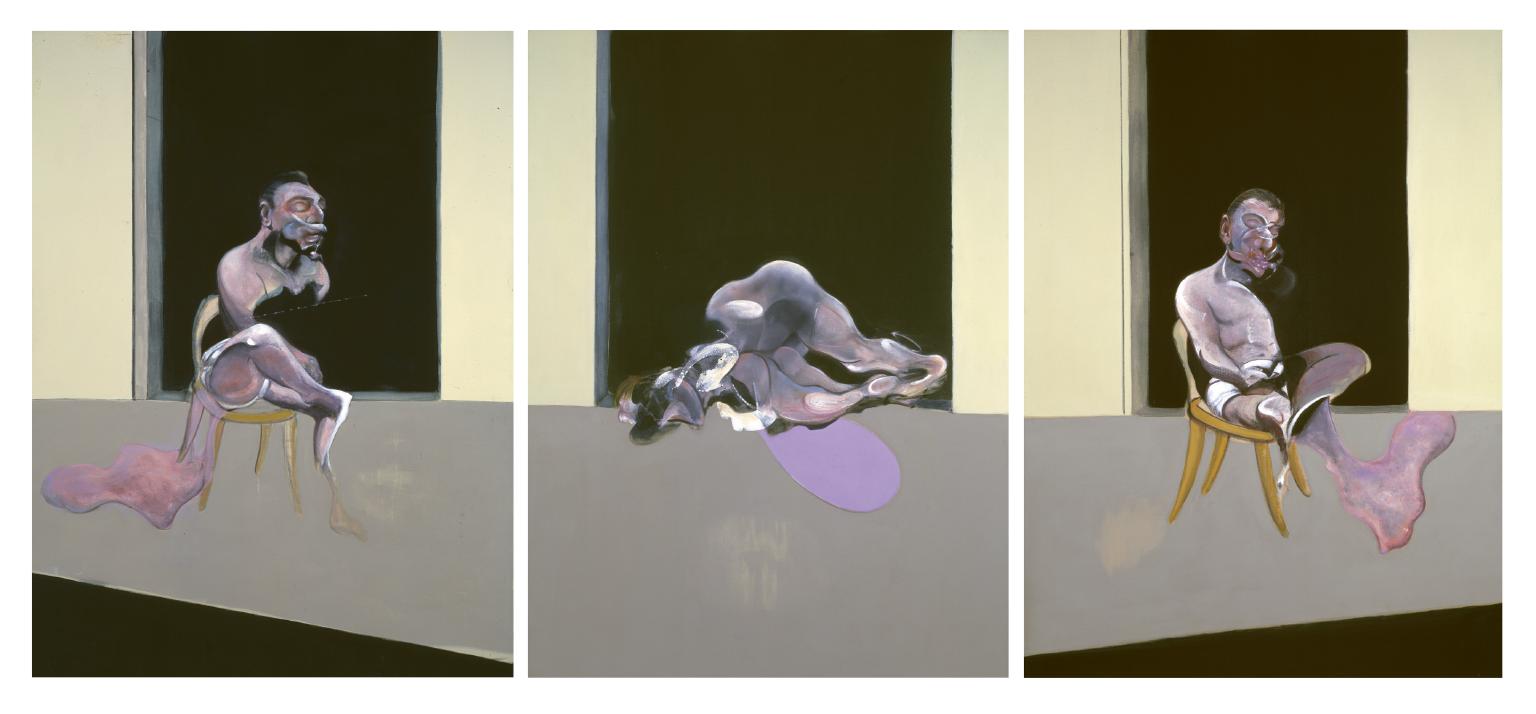 Chapter
1 The Round Area, the Ring.
We find lots of round areas, sometimes ovals, sometimes in the form of round shares or even in discs or spirals painted around the body. These serve as a kind of circus ring, a place, intended to isolate the Figure. Sometimes the Figure is put inside a box or located on rails. The idea is to convey mobility, some sort of exploration of the Figure in a place. The relation to the place will be understood as a fact. 'The Figure becomes an Image, an Icon' [but not a signifier]. Bacon wants to avoid the 'figurative, illustrative, and narrative' aspects of figures (2). His painting does not represent anything or tell a story. Painters in the past have escaped by heading for pure form or the purely figural, either through abstraction or extraction. The point is to oppose the figural to the figurative [a note refers us to Lyotard]. In ordinary figurative painting, there is an implied relationship of an image to an object and also to other images, permitting both illustration and narration, a story in between different figures [I think the viewers will supply this anyway]. There is a need to isolate and illustrate the Figure, 'to stick to the fact'. It might be possible to produce 'diverse figures that would spring from the same fact' to achieve the same ends. Bacon might be doing this with his coupled figures, or the relationship between the panels of the triptych. Classical painting has allowed narrative to creep in, and this will '"cancel out the possibilities of what can be done with the paint on its own"' (3). What might factual relations look like, without any attempt to offer more conventional intelligible ones? Bacon's Figures have broken with the convention of putting something like a landscape behind a figure, or a ground from which the figure might emerge. He did try these at first, but progressed to 'a set of short "in voluntary free marks"', sometimes looking something like grass. Thick and blurred textures in the background are related to the local scrubbing and blurring of the Figures, which extends them into a 'non-figurative zone' (4). Bacon therefore has a system which is following. The fields of colour structure and spatialize and are adjacent to the figure. We can see this in close-up view, a tactile or haptic one [another note refers us to an earlier art historian who says that a distant view gives one perception, but a close view enables us to see something of texture, something tangible]. There is no relation of depth. Instead, 'two sectors on a single plane, equally close'are correlated, inside the ring or round area which is their common limit. [Deleuze says we can think in sculptural terms which will enable us to see mobility, and says this is hinted at in a painting like Man with Dog — we see sidewalks, pools, and people emerging from pools]. There are connections with earlier art forms, including Egyptian, but Bacon has a system involving two adjacent sectors enclosing space, depicting space better than simply something in the background which is indistinct. Both space and Figure are blurred in a spirit of '"destroying clarity by clarity"' [a note refers to a commentary on Tati films, where two dialogues are heard simultaneously and equally clearly, with the intention of rendering both insignificant]. We see this say in the depiction of newspapers which are illegible despite having certain clear characters. Chapter 2 Note on Figuration in Past Painting Painting 'extracts the Figure from the figurative''(6). Bacon says he wants to do this because photography already illustrates and documents, and secondly he wants to break with religious possibilities in earlier attempts to do painting, and instead pursue 'an atheistic game'. Deleuze has his doubts. Photographs do more than just represent or illustrate, as Bacon knows when he uses his own photographs. Similarly, religious sentiment did not prevent nonrepresentational experimentation [some brilliant examples here including Giotto's Stigmatisation]: in heavenly matters, for example, there is no need to preserve simple realism, but rather to portray sensations. The word of God is not limited by conventional aesthetics. Classical paintings sometimes liberated Figures.  Nor does modern painting easily liberate itself from existing photographic and artistic clichés [the famous bit]: 'the entire surface is already invested virtually with all kinds of clichés' (8). Abstract painting already realized that it was a struggle to break with these. Bacon knows this when he says that photographs are not simple, but represent 'what modern man sees'. The real danger is that this will replace actual vision, including that formerly depicted in painting. Chapter 3 Athleticism There is a double relationship between the Figure and the place, the ring. We see this by looking at actual contours [boundaries or those strange structures made up of lines?]. These relate both 'the material structure and the Figure], and the Figure and the field, working as a kind of membrane. Often, the Figure appears to be waiting for something, although this is neither a spectacle nor a representation. The Figures are '"attendants"' (9). Both spectators and spectacle are to be avoided [and the second painting of the bullfight makes this point best because there are no forms of access for spectators, merely a connection between toreador and bull]. Sometimes spectators are deliberately excluded by closing a door. However, there must be
an attendant, not a spectator but included
in the Figure — sometimes as photographs or
paintings hanging on walls. They are to be
seen as 'a constant or point of reference in
relation to which a variation is assessed'
(10). [Apparently, there is a resemblance to
Kafka]. We can see all these features in the
Painting of 1978 — the contour or
round area migrates from the ground to the
door, giving the illusion that the Figure is
standing on the door [note the arrows too
--variously explained as non-realist,
borrowed images etc] 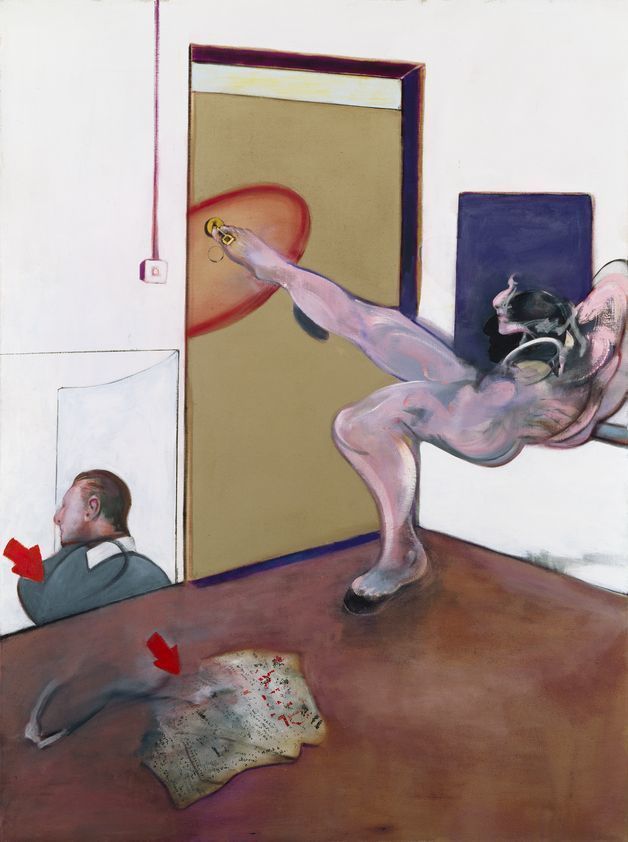 The Figure often shows athleticism, but not for its own sake, rather something derived from the material structure or field — a cylindrical field carols and imprisons the figure, boxes confine bodies. This conveys movement on the Figure which it continues. What we get is 'a derisory athletics, a violent comedy in which the bodily organs are prostheses' (11). The Figure also moves
toward the material structure and the field.
Something comes from inside the body which
requires an effort. These efforts are not
the result of some superhuman ego, but come
from the body itself, in the form of a
spasm. The body seems to attempt to escape
through various exits like drains or the
points of umbrellas [with a quote from
Conrad about a prisoner trying to escape
through a viewing hole]. Sometimes a
particular organ takes the lead in vomiting
or excreting. The shadow becomes important
to point to a body that has escaped from
itself. The scream shows the body escaping
through the mouth. [I like this umbrella
painting below, Painting 1946. One
of the crucifixion series. Also shows
the armature, of white lines in this case] 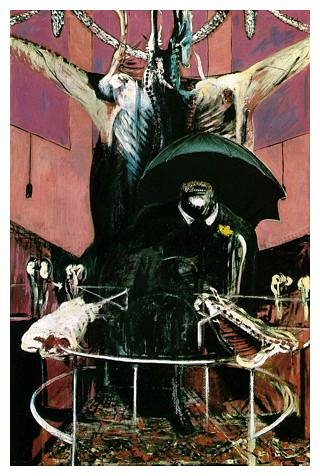 So it is no longer that the material constrains the Figure, more that the Figure itself wants to disappear into its surroundings. Here, the contour indicates a volume for escape. Umbrellas appear more than once as contours like this. There is a connection with Burroughs on how characters want to try to escape through their cocks. The painting with the hypodermic syringe should similarly be seen as a body attempting to escape through the syringe. There are also mirrors which bodies can enter. Bodies elongate or flatten in mirrors. The Figure is not only
isolated but deformed, and this is movement
of the figure itself. The deformed body
escapes from itself, and must return to the
material structure. We see here depicted
'passages and states that are real,
physical, and effective, and which are
sensations and not imaginings' (13). We see
in mirrors what happens. Sometimes the whole
structure acts as a mirror. Overall, there
is a constant and intense movement 'that at
every moment transfers the real image onto
the body in order to constitute the Figure'
(14). Chapter 4 Body, Meat
and Spirit, Becoming–Animal 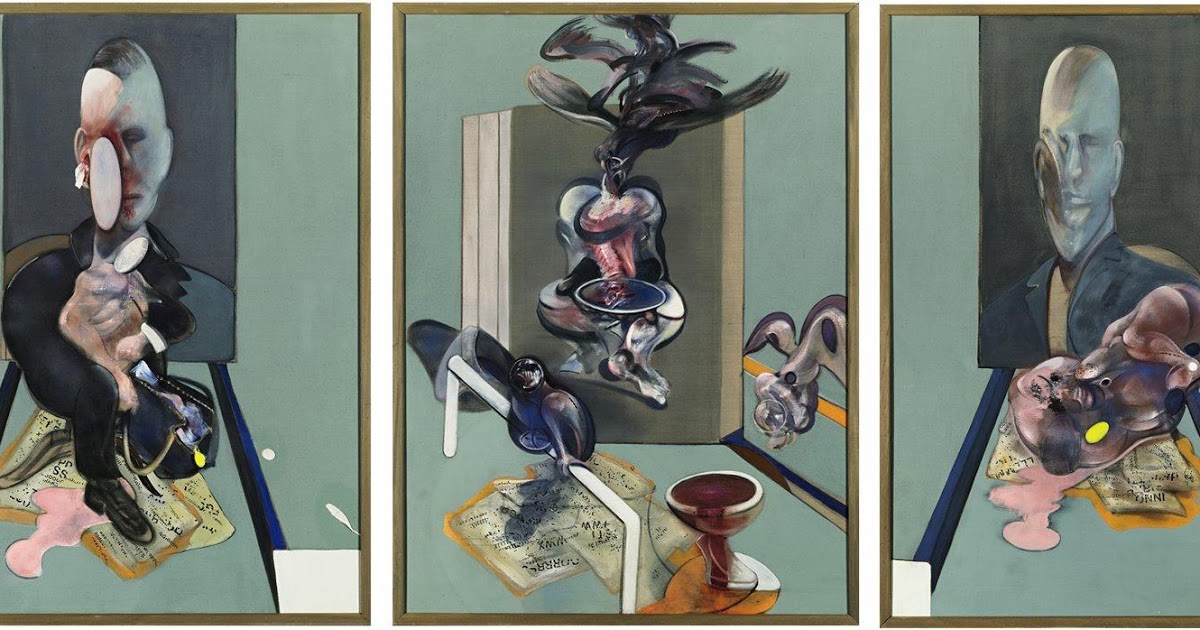 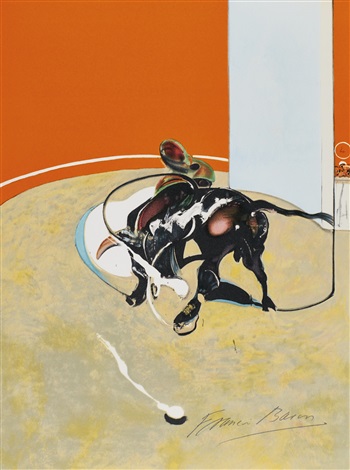 Indiscernibility of the
entire body arises because the body is flesh
or meat, only structured by bone, and
revealed only where bones are removed. Flesh
becomes bodily material. Bacon paints meat
as 'the body in which flesh and bone
confront each other locally'. The mouth and
its teeth can be seen like this too. The
flesh descends from the bones, or bones are
raised in the form of a raised limb. In
these, the bones take the form of 'a trapeze
apparatus (the carcass) upon which the flesh
is the acrobat' (17). We see the same things
in the crucifixions. Meat is the object of
pity, since it retains suffering and
manifests pain and vulnerability as well as
'delightful invention, colour, and
acrobatics'. Thus meat 'is the common zone
of man and the beast, their zone of
indiscernibility' [surprisingly literal
example of this concept]. Bacon himself
confesses to being emotionally moved by
slaughterhouses and meat, a kind of empathy
[maybe] in that meat becomes ourselves, the
spectator is in the spectacle, animals are
part of humanity but also 'we are all
cattle' (18) [actually referring to another
writer, a certain KP Moritz]. This is not
just resemblance or sentimental
identification but 'a deep identity… The
reality of becoming' [felt by all
revolutionaries, apparently]. Chapter 5
Recapitulative Note: Bacon's Periods and
Aspects  Here, bodies are no
longer confined but are perhaps shielded by
curtains and partially hidden. Bacon is
deliberately exploring again the blurry and
indeterminate, depth and sickness. There is
a German term malerisch [a note on
page 128 says this used in earlier art
history, referring to '"that depreciation
and gradual obliterated of line (outline and
tangible surface) and for the merging of
these in a 'shifting semblance' of things —
it is an attempt to represent that they and
in palpable essence of things"']. 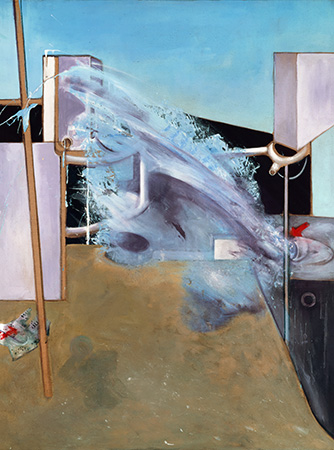 'Painting is this
coexistence' (23). There is a first movement
of tension, from structure to Figure, where
the structure can Carroll around or isolate.
The second movement of tension goes from the
Figure to the structure, contraction or
dilation as escape, 'an extraordinary
becoming – animal', eventually dissipating
into the structure leaving only a smile,
where the contour becomes a curtain,
concealing not enclosing the Figure. So the
contour already had a number of functions —
isolation, but also a '"depopulator" or…
"deterritorializer"', cutting off any other
background. Then the contour deforms the
Figure as it passes through a hole. Then it
becomes a curtain where the Figure is
dissolved 'by joining with the structure'
(24). In each case it acts as a membrane
offering two-way communication. We can
understand this communication as systolic,
contracting the body and diastolic which
extends and dissipates it, sometimes finding
both in the same body. 'The coexistence of
all these movements in the painting… Is
rhythm' [original ellipsis] Chapter 6 Painting
and Sensation 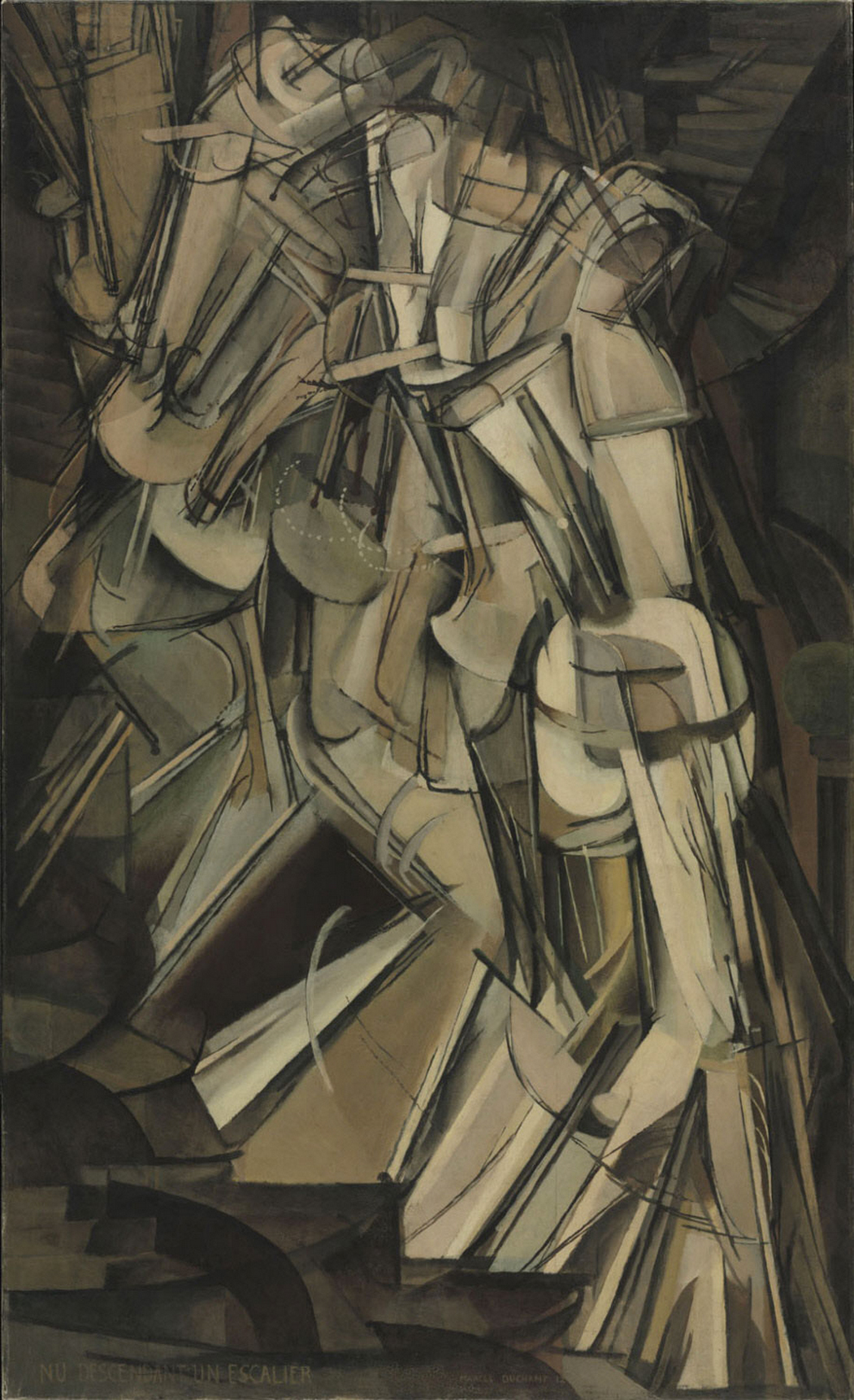 Bacon also likes [and
borrows from -- see Davies and Yard] those
early photographs of movement as a series of
stills in Muybridge [lovely one below] 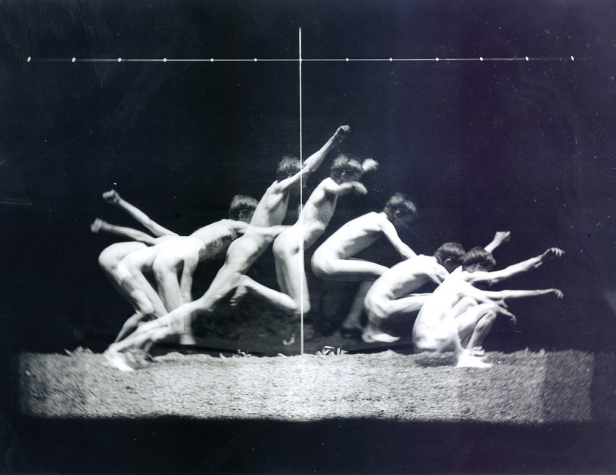
He paints intense
movements, [blurred] turns of the head, for
[one] example. Sometimes, the Figures appear
to be frozen in the middle of movements.
There is also an interest in 'mobile
sculpture', painted as movements along the
armature. The mundane daily round of
movement is also found in Beckett's
characters. Figures often show 'amoeba –
like exploration'. These movements are
explained by sensation and its elasticity
[with some strange connection to Beckett or
Kafka about the necessary connection with
immobility 'beyond movement']. Bacon is most
interested in 'a movement "in–place," a
spasm' (30), something showing the action of
invisible forces on the body. Chapter 7 Hysteria 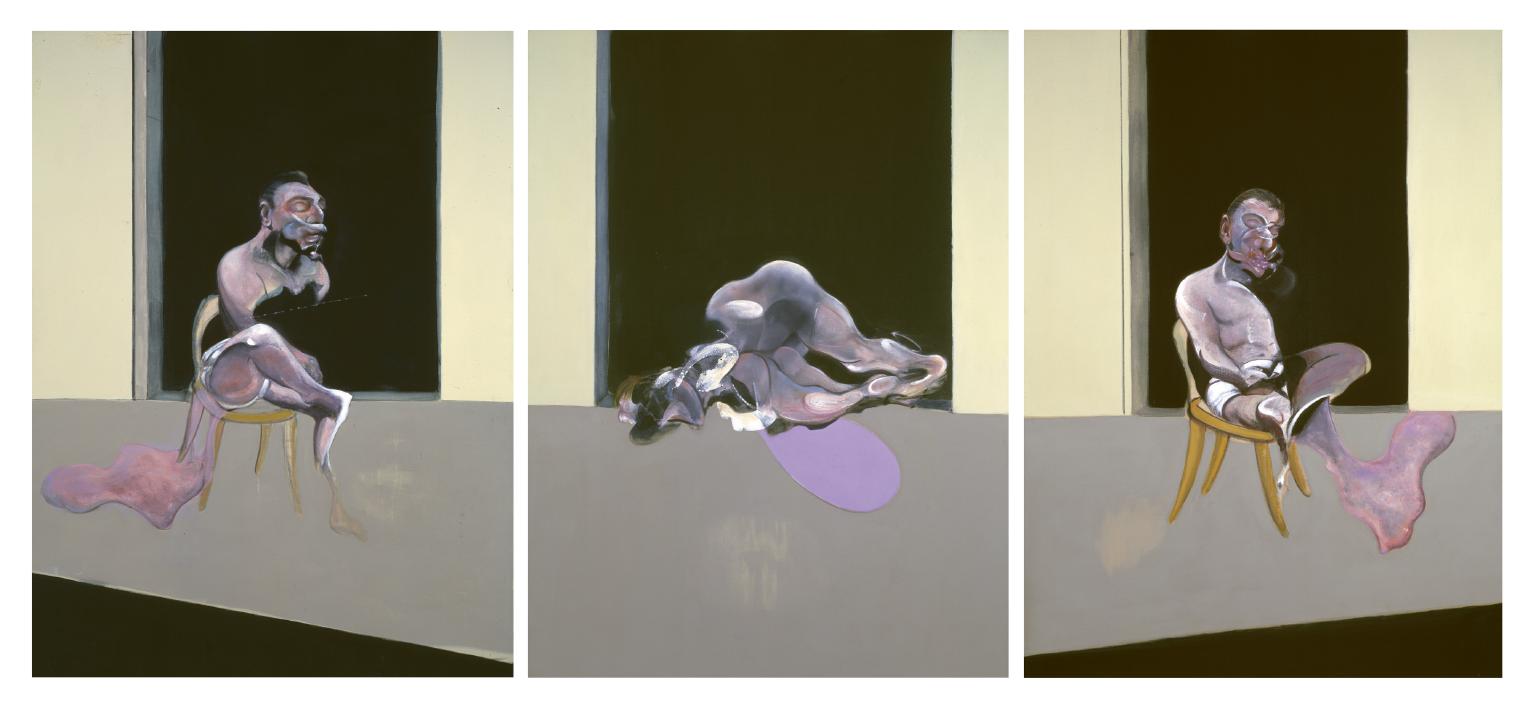 There are always dangers
in constructing such clinical analyses
[which Deleuze has tried out before, of
course,with literature] and there is the old
problem of where hysteria lies — in Bacon,
in the painting, in painting in general [or
in the critic or viewer?]. Painting has a
special relation to hysteria, trying to
'release the presences beneath
representation'. The colour system is
important here in that it acts as 'the
system of direct action on the nervous
system' (37) [ I still prefer the
phenomenological insistence on perceptual
unity here including subjective elements] .
Thus all painting turns hysteria into art,
even though hysterics themselves cannot do
this. This is not to say that the painter is
hysterical, certainly not in a negative way.
Instead, the horrors of life turn into some
pure and intense life itself, and painting
releases 'all the joys of line and colour'.
This is how cerebral pessimism becomes
nervous optimism. Painting converts hysteria
by making it visible. At the same time, it
liberates the eye from its conventional
character 'as a fixed and qualified organ',
allowing it to become polyvalent and
indeterminate, so that we can detect other
presences, like the BwO or the Figure. This
is because 'Painting gives us eyes all over:
in the ear, in the stomach, in the lungs'
[which might be a philosophical way of
saying it engages the other senses]. These
subjective changes in our vision are
accompanied by objective presentations of
the reality of bodies, lines or colours. The
two changes are required simultaneously —
'the pure presence of the body becomes
visible at the same time that the eye
becomes the destined organ of this
presence'. 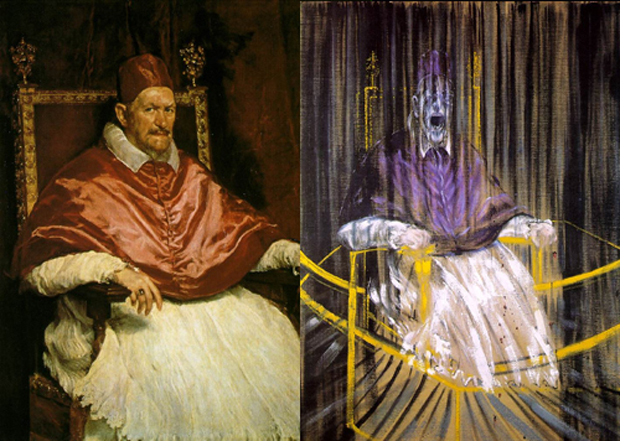
Can we talk about
hysteria as a purely aesthetic matter.
Doesn't music also 'extricate pure
presences', where the ear has become 'the
polyvalent organ for sonorous bodies'? What
about poetry and theatre, Artaud or Beckett?
For Deleuze, music involves our bodies in a
particular way — 'it disembodies bodies'
(39) as a way of overcoming the resistance
of any 'inert matter'. It does this in a
further direction then painting, hence its
'superiority'. Painting enables bodies to
escape only to discover their materiality.
Only eyes 'can attend to material existence
or material presence', but music does not
attend to the material reality of bodies,
and does not illustrate hysteria. Its
connection with spirituality arises from its
operation with disembodied bodies. There is
no equivalent to colour [although there
might be 'rudimentary or refined system of
correspondence between sounds and colours'].
Thus music is not hysterical, but rather
illustrates 'a galloping schizophrenia'. Chapter 8 Painting
Forces 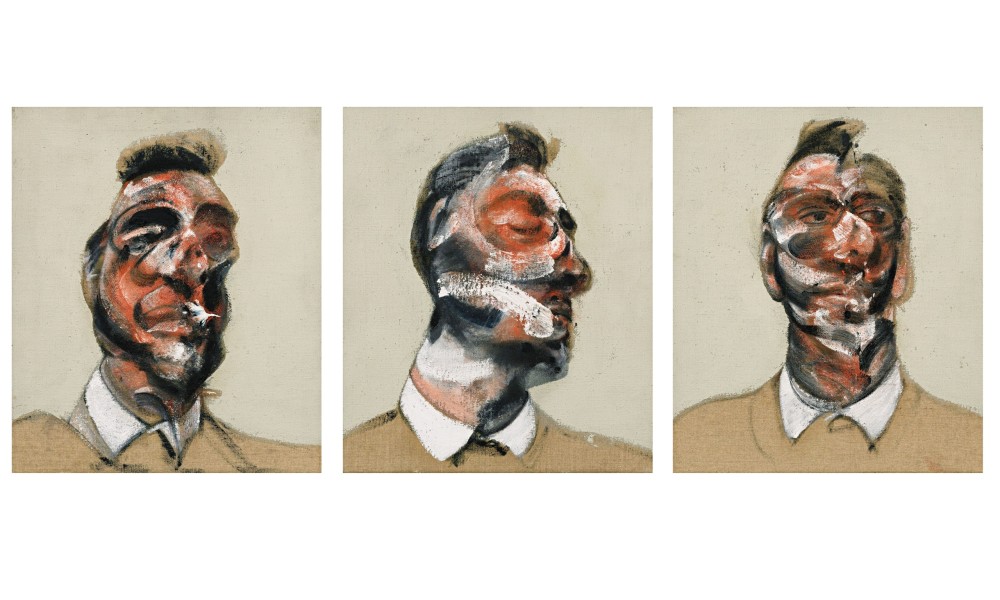 Bacon sees the scream as
particularly important, painting the
relationship between forces and the visible
scream [the screaming mouth]. The actual
spectacle is not important, but rather the
forces that produce spectacles, 'and that
even lie beyond pain and feeling' (43).
There is often a dilemma to paint either the
horror or the scream [there are musical
examples too]. Bacon attempts to show the
relationship between the visible open mouth
as an abyss, and visible forces, 'which are
nothing other than the forces of the future'
[with a reference to the same phrase in
Kafka. These future forces are anticipations
of some dreadful events to come?]. For
example, we scream at death, as an
example of coupling the scream and the
force. Since sensations are the result of waves of force, they can also communicate. Resonance is one form [I am still unhappy with this except as some general metaphor -- for one thing, resonance is not the only form of sympathetic oscillation, which include the interference patterns beloved by Barad,who sees them as universal. For another -- physical, optical and electro-magnetic forms of resonance clearly involve transmitting forces. As a metaphor, I am not sure if Deleuze is suggesting amplification of sensations, reciprocation, interference patterns or all 3. I think he likes the term because it just suggests some mysterious interactions between forces, about as precise as 'life force' ]. Thus two Figures can be coupled with coupled sensations, despite sharing a 'matter of fact' (46). There is always a danger of having several Figures because that might reintroduce narrative, but they can still show relations, remembering that 'what is painted is the sensation'. So where there are entangled Figures, there is no merger but rather an indiscernibility provided by precise lines which almost become autonomous, a diagram. There is no story. [See below]. Even single Figures show can show different levels of sensation, implying a kind of coupling [referring to the crucifixion scene above]. Figures can be coupled with their animals. 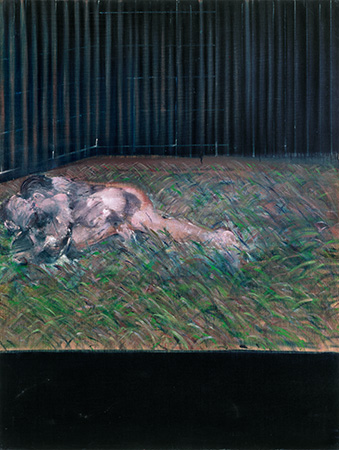 There is a link to Proust and involuntary memory. Proust also did not want an abstract philosophical literature or a figurative or narrative one. He wanted 'a kind of Figure, torn away from figuration and stripped of every figurative function… For example the Figure–in–itself of Combray' (47). To rely only on voluntary memory is to risk illustrating or narrating the past. For Proust, involuntary memory linked to sensations at different levels of the body — the present and the past sensation which when related produce something irreducible to either of them [their location in past or present became 'of little importance' (48)]. Some sensations did not appeal to memory at all [the examples are paintings or Vinteuil's music] and there are moments where two sensations resonate in music, such as the violin and the piano: the Sonata becomes a Figure, as does the septet, relating spiritual calling with bodily pain. The two sensations are coupled together 'like "wrestlers"… a "combat of energies"', together producing 'an ineffable essence, a resonance, an epiphany'. Proust imprisoned [Combray {'in a cup of tea'} or Albertine] 'in order to capture their colours'. Bacon does not like to paint the dead, or to paint people in front of him. He prefers photographs or memories, but memory is not actually key itself — it is the confrontation of two sensations, not always negative. Desire can mix together sensations as can 'sleeping… art': 'places of a struggle'. What about the triptych? There is a relation between separated parts, again neither narrative no logical, no progression. There is 'a common fact that [unites] diverse Figures'(49). The figures do not resonate. There are 'nonnarrative relations… matters of fact or common facts'. We should not impose a narrative on Man and Child, for example — maybe we are being shown all possible narrations. Here the fact of the painting must include the separation of Figures. Maybe the girl is an attendant, neither observer nor spectator, but only 'a constant, a measure or cadence' against which we can assess variation (50). The girl is stiff while the man seems to be in motion.. Beckett has attendants too [characters who seem to comment or interrogate themselves]. The attendant can be the circus ring or camera, sometimes two or more if there are several Figures. 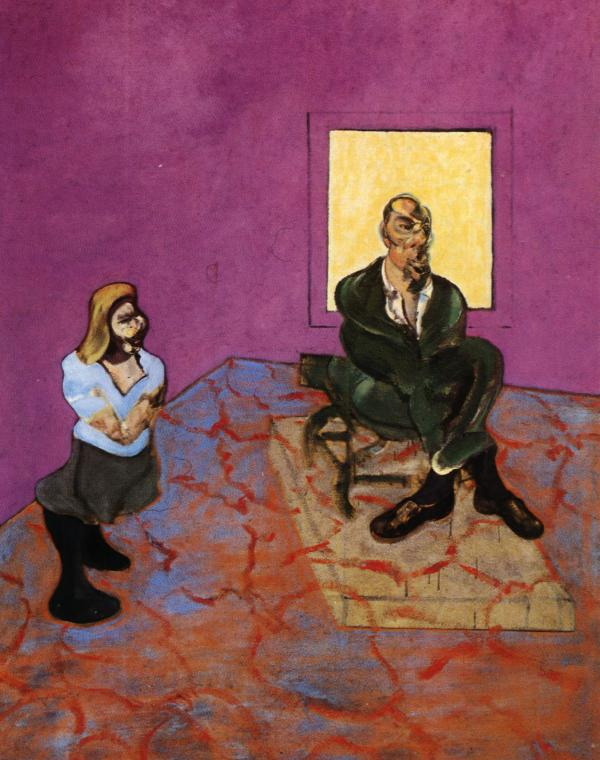 We get the three rhythms mentioned earlier — active, passive and attendant. These are not located in the Figure, indeed [given the necessary philosophical sensibilities] 'it is rhythm itself that will become the Figure' [with another link to Messiaen claiming that he uses different rhythms as characters, one active, one passive, one attendant inactive]. The triptych was itself once mobile [movable wings?]. Bacon however 'makes the triptych equivalent' [!] to music rather than furniture, distributing three basic rhythms in a fundamentally circular organization. So Bacon paints sensations, 'essentially rhythm' initially in the Figure: 'the vibration that flows through the body without organs' (51). In coupling of sensation rhythm is partly liberated as resonance, but still constrained by 'the melodic lines, the points and counterpoints of a coupled Figure;it is the diagram of the coupled figure'. In the triptychs, rhythm is amplified in a forced movement 'which gives it an autonomy, and produces in us the impression of time' [pass] sensations now have no limits as figures are placed in all sorts of directions. This in turn produces 'recomposition or redistribution' so that the rhythm itself becomes sensation or Figure. Apparently Rembrandt and Soutine offered earlier versions — residences in layers, amplitude of light, the distribution of active passive and attendant Figures in the Night Watch, even in still lives, where glasses can be attendants, with spirals of lemon and mother-of-pearl opposing each other.  Chapter 10 Note: What Is a triptych? [An absurd pseudoscientific opening paragraph saying 'the hypothesis must be verified {about the three rhythms}... We can respond to this question only through an empirical study of the triptychs'. The paintings are empirical 'facts': Deleuze takes Bacon at his naive word here. He actually relies on lots of other words in texts as well Bacon's interviews and other commentaries on other painters as seen in the notes. He has already deployed non-empirical concepts like BwO. He has not the faintest idea how to verify hypotheses with empirical data, of course, and covers his back already: 'since this order, if it exists, combines many variables, we must expect it to present very diverse aspects' (53). It is clear that no empirical example will ever falsify the hypothesis, and that any apparent exception can be explained simply as one of the many diverse aspects and combinations]. There are different sorts of attendants [and there are many examples referring to characters, nude and clothed, observers and photographers, simulacra of portraits]. There is another kind of attendant function as well, something 'more profound', something that sees the more superficial attendant. The attendant function turns on 'horizontality, it's almost constant level'. This can offer a rhythm that works in two directions ['retrogradable in itself'] and does not increase or decrease: the other rhythms of vertical and are 'retrogradable only in relation to each other' (54). We find the horizontal feature in the triptychs — the 'flat hysterical smile' for example. We are also presented with horizontals that offer a translation from one panel to the next, may be as 'a prone body' or a flattening force [lots of examples to illustrate]. There can be a 'horizontal diagram' of couples as in Sweeney Agonistes [below -- apparently the title of a poem by TS Eliott]. The very complexity shows 'an underlying law', where attendant rhythms appear first as visible characters, later as a separate 'rhythmic character'. That can happen when something with an active or passive rhythm acquires an attendant function — the sleeping characters can also show activity or passivity, vivacity [Sweeney again]. Sometimes characters cease to be attendants and can acquire other characteristics — they also rise or fall, or change. 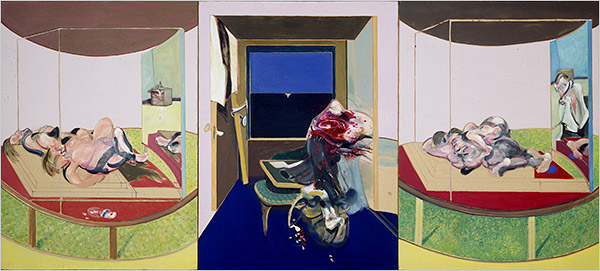 The other rhythms, active and passive, are found in a vertical dimension, sometimes simply depicted with descending or inverted heads, sometimes by recumbent forms next to one that appears to rise up from its shadow or descend into a puddle. These will be examples of 'a diastolic – systolic opposition'(55), linked contractions or expansions, sometimes where particular figures are depicted very contracted. The Studies of the Male Back shows some oppositions between something large and relaxed on the left and tense on the right, with the centre panel remaining constant [I'm not sure this is the one he means]. 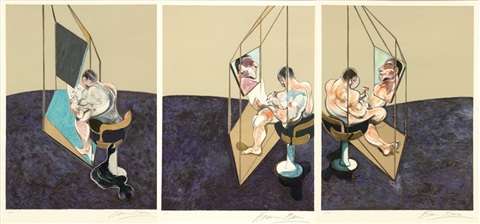 Other oppositions include those between naked and clothed figures, which stands for the 'augmentation-diminution opposition' (56). This can also be indicated by apparently random extra 'spurts of paint', or missing portions of Figures, a whole 'game of added and subtracted values'. These are 'Bacon's most profoundly musical paintings'. The oppositions are not equivalent, but rather offer a 'combinatorial freedom' (57), so a discharge [the example seems to mean the discharge of vomit] can be a descent as well as a dilatation and expansion, and can also stand in opposition to other figures as a contraction. 'Everything can coexist and the opposition can vary or even be reversed depending on the viewpoint one adopts, that is, depending on the value one considers' [quite so]. What remains common is that one rhythm is a retrogradation of the other, set against a constant attendant rhythm. Within the variability, 'in Bacon, primacy is given to the descent… It is the active that descends'. [To cover his back --sorry] sometimes, the descent can refer to sensation rather than a descent in space. Many other artists have depicted a difference of intensity in sensation as a fall [a note refers us to another commentary]. With Bacon, flesh descends from bones and sensation develops by falling from one level to another. We should not understand the fall in thermodynamic terms, as entropy, but merely as emphasizing the difference in level as such. It shows us the experience of tension [with an obscure reference to Kant page 58, who apparently argued that the plurality of intensity could only be grasped by reference to negation] — even attaining a maximum is experiencing a kind of fall. It is the 'most inward movement or "clinamen" of sensation', not a matter of misery or failure, and it is not the same as a fall in space 'except for convenience and humour' [so I think we've covered all the grounds]. Thus an intensive fall can also 'coincide… with a rise', both a diastole and a systole, because it is 'the active rhythm'. It follows that 'everything that develops is a fall', which makes it possible to identify in each painting what counts as the fall, although this will vary from one painting to another. There will also always be an opposable character to assume the role of a passive rhythm. We are now going to summarize the 'laws of the triptych, whose necessities grounding in the coexistence of the three panels' [roughly that there are three rhythms; one is an attendant rhythm which can circulate through the painting both as visible characters and something that is just rhythmic; and that there are active and passive rhythms with a number of variations]. Naturally, 'these laws have nothing to do with the conscious formula' but are rather a part of 'this irrational logic, or this logic of sensation, that constitutes painting' (59). They are not simple or voluntary, they do not follow the same succession, say from left to right, nor is the centre panel always given a 'univocal role'. What they imply changes. They are found in extremely variable terms, affected both by 'their nature and their relations'. We end with a state of complex forces. Which forces are triptychs specifically responding to? We have already spotted forces of isolation and formation and dissipation between Figure and structure, and movements between Figures like coupling and deformation. But there is a third movement and force in triptychs, even though it can include the others. It turns on the relations between Figures 'which are violently projected onto the field, and are now governed by the uniform colour or the naked light'. The Figures appear 'like trapeze artists whose milieu is no longer anything but light and colour' [Three Bodies,below] [Deleuze also notes a 'rare exception']. The light and colour both unifies and separates the Figures, 'a force of separation or division sweeps over them' and this is not the same as isolation. Overall we find 'the maximum unity of light and colour the maximum division of Figures'. Rembrandt also realized that light can produce 'rhythmic characters' [in the Night Watch, apparently]. 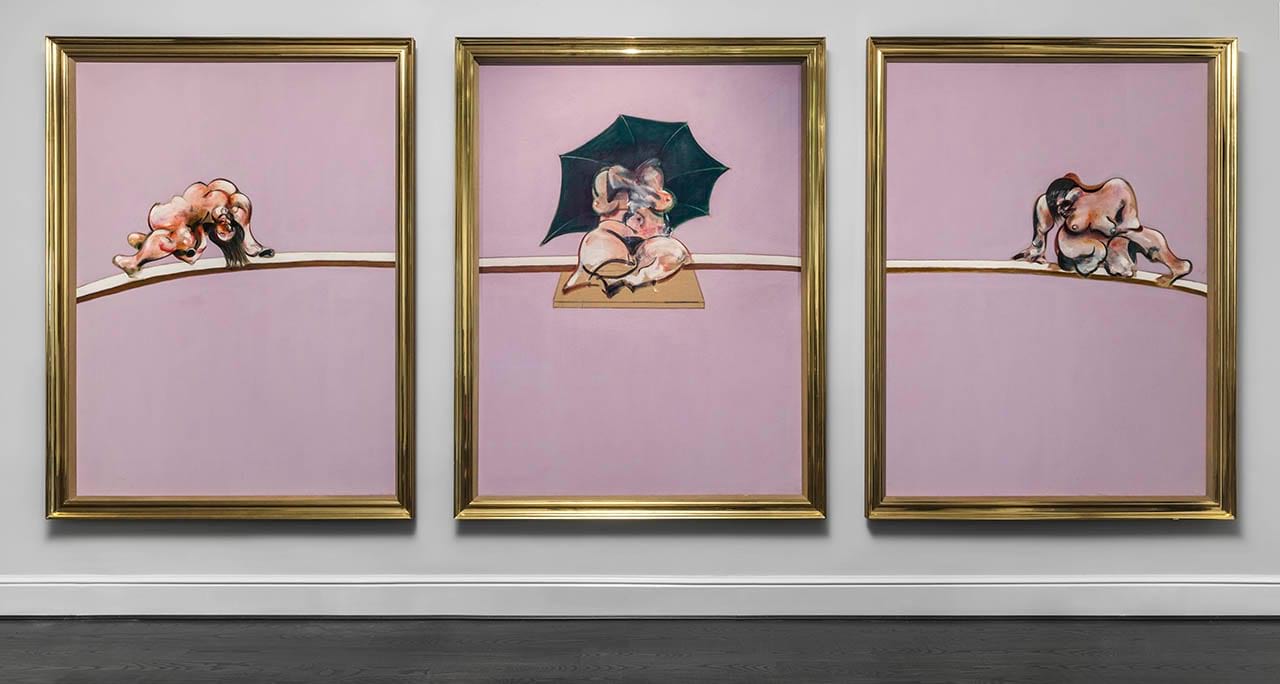 The body of the Figure therefore 'passes through three levels of force', seen best in the triptych. We have primary 'facts' however — the Figure which is to be submitted to forces, then 'first "matter of fact"', where two Figures are coupled. Finally, in the triptychs, the bodies are separated in 'universal light and universal colour that becomes the common fact'. This is both unity and separation, shown in paint as 'the colour field separate while falling into the white light'. Everything becomes aerial. Time is only depicted as 'monochromatic eternity. An immense space-time unites all things' but only by also introducing the notion of distance, both in the landscapes and in the panels of the triptych. The three panels are separated but not isolated, the borders refer to the 'distributive unity of the three'. This triptych form is [somehow] universal in Bacon. Chapter 11 The Painting before Painting… [The famous one about clichés]. The painter never works on a blank canvas, which is why figurative painting doesn't work if it claims to just represent external objects. There are many other things in the painter's studio or 'in his head' (61) and these are present 'more or less virtually, more or less actually, before he begins his work'. Painters have to empty the canvas first, to over paint images that are already there, to replace 'all those "givens"', which appear as an obstacle as much as a help. There are for example, 'figurative givens', arising from earlier paintings or photographs, television and so on. This provides us with 'psychic clichés… Ready-made perceptions, memories, phantasms'. 'clichés are already on the canvas'(62). It is no good just trying to transform or deform them because 'this reaction is still too intellectual, too abstract', and the cliché can be resurrected. At best we can parody. [Then a long quote from DH Lawrence on Cézanne, 62 – 63. Cézanne wanted to spend his life painting a real apple rather than clichés of an apple. He went through deliberate distortions sometimes parodies. Apparently '"he wanted true to life representation. Only he wanted it more true to life"'. Photographic conventions were already obstacles to this. Sometimes, apparently he managed to give '"a complete intuitive interpretation of actual objects… The real appleyness"' (63), but this can never just be imitated]. It is worse now that images have multiplied, and 'even the reactions against clichés are creating clichés'; abstract painting produced its own clichés. Lots of other people know this, and 'the Japanese know that whole life barely suffices for a single blade of grass' [!]. Painters experience painting as a struggle and are often extremely critical of their own work, including Bacon. Bacon likes and uses photographs, but sees them as having no aesthetic value, which is why he likes the documentary kind like Muybridge, even if they are illustrative or narrative. However, Bacon sees that photographs work in two ways — 'by resemblance or by convention, through analogy or through a code' [sounds like the classic iconic signifier, although that has both rather than either/or]. They also take on an existence of their own, which can dominate perception, in this case people or landscapes that are being depicted: 'what we see, what we perceive are photographs' (64). Photographs make implausible or doctored images appear as truth. Bacon celebrates these developments. For him photographs are something that exist, imposing themselves upon perceptions and thus being able to 'lay claim to aesthetic pretensions'. They do not succeed because they reduce sensation to just the one level [needs much more explanation. A note on page 133 refers to Foucault's essay on photography and painting, and notes cases where painters integrate photographs or the action of photography. Seems to me to be little more than an argument that visual realism is never realistic. Deleuze seems to have a different emphasis in the books on cinema, possibly because movement adds levels?]. Art offers a different sort of deformation [but Eisenstein is mentioned as an exception, possibly because the famous shot of the wounded nurse in Battleship Potemkin has been borrowed for one of Bacon's scream paintings?] 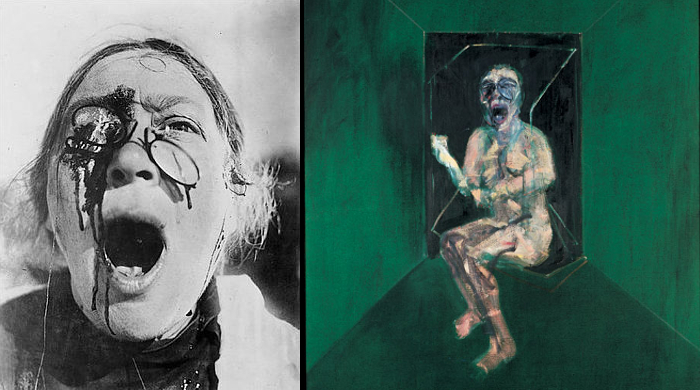 Bacon has not attempted to integrate the photograph into the creative process. He does paint things that seem to function as a photograph, as attendants — cameras, a rifle. But photographs on their own are more valuable. So they cannot be left behind or transformed. Better to understand them as 'so many pre-pictorial givens' (65) It is necessary first to develop '"the will to lose the will"' [apparently a phrase Bacon uses in the interviews], to go beyond the givens. This seems to be particularly suitable with photographs, although different givens require similar stances. Bacon talks about chance for example, which he uses to develop 'rules for rejection and very precise action'. It is not the normal understanding of chance, however. Chance has two parts, with only the second found in painting. We understand the first notion by thinking of the blank canvas as offering somewhere where 'all the places on it seem to be equivalent… all equally "probable"' (66), limited only by the definitions of the canvas itself, its limits or centre. What the painter wants to do, 'what he has in his head', then privileges particular places, the 'pre-pictorial idea'. This introduces a distribution of equal and unequal probabilities. The trick seems to be to make the unequal probability 'almost a certitude'. Painters can then proceed, but they still have to beware the cliché. They can use '"free marks"', commonly referred to by Bacon, made quickly, 'so as to destroy the nascent figuration… And give the Figure a chance, which is the improbable itself'. The marks are accidental, by chance [what would Freudians say about that?] in a special sense, no longer designating abstract possibilities, but referring to 'type of choice or action without probability' [is this not really choosing the improbable rather than another kind of chance, although the free marks introduce certain nonrepresentative marks]. These marks are made by the hand of the painter [without thought?]. They help the visual image of the Figure emerge. But it is accident and chance in the second sense that are at work. Bacon apparently refers to 'manipulated chance, as opposed to conceived or seen probabilities'[Much of this appears to be based on a theory by a certain Servien who distinguished probabilities, which can be calculated, 'and which concern the dice before they are thrown', and chance which he understands as 'the type of choice, nonscientific and yet non-aesthetic'. This seems to me to be another way of describing the effects of the Unconscious. It might link with the several other commentaries about dice throws? This seems 'spontaneously close to Bacon's conceptions, and seems to be distinctive against those who see 'art as play']. Much depends on whether the game offers combinatorial moves like chess, or throw-by-throw moves like roulette. For Bacon, art is roulette, played at three tables, like the three panels of the triptych. So there is 'a set of probabilistic visual givens', and Bacon can 'abandon himself' to them. They are pre-pictorial and will not be integrated into the painting itself. However the choice made at each move becomes pictorial, appearing as manual marks that reorientate the visual, and will eventually 'extract the improbable Figure from the set of figurative probabilities' (67) [seems pretty similar to the deliberate introduction of random elements, like found art or even like Roussel's writings? But..]. This has often led to misunderstanding when Bacon talks about chance. For example Duchamp used a technique to let three threads fall on the painting. This would be using the pre-pictorial givens as part of the painting, not what Bacon does. When asked if anyone could make random marks, Bacon replied that they could do so abstractly, but would not know 'how to utilize this chance or how to manipulate it'. It needs manipulation to turn chance into something pictorial, an act of painting. Bacon was to insist that there is only manipulated chance or utilised accident, against the views of his colleagues and friends. So what we see is a stance of 'reckless, almost hysterical abandon' towards clichés and probabilities, which are always there. The painter must fully embrace them ['must enter into the canvas before beginning']. He knows what he wants to do, but does not initially know how to get there, requiring a step out of the canvas. In this sense, we are always in the canvas, in the pre-pictorial, but the trick is to get out of cliché and probability. Random manual marks give him a chance [sic] to do this, even though they can actually add nothing or even 'botch' the painting (68). To fight against clichés requires 'much guile, perseverance, and prudence' renewed at every moment of every painting. 'It is the way of the Figure' [pass!]. It is not enough to abstract from the figurative. The Figure is always still figurative, it represents something and narrates something [quite so, especially for the viewer, although Bacon hopes that these representations and narrations are not the conventional ones. For him they might even include 'a surrealistic tale (head – umbrella – meat...)'. Overall, there is a complex opposition of the Figure to the figurative [rather than admitting that Bacon has failed to fully oppose them], one that does not compromise the opposition. First there is a pre-pictorial figuration, a cliché, a probability, which can never be 'completely eliminated'. But there is a second figuration arising from the act of painting, and this time it is the 'result of the Figure… an effect of the pictorial act' [well I can see that it's an effect of an act, but making it the result of the Figure is just excessive philosophising?]. There is a 'pure presence of the Figure', a representation that has been reconstituted, a figuration that has been recreated. The photograph does the first figuration but is not adequate to reality, and has to be recovered. This takes place only after 'a leap in place… a deformation in place, the emergence in place of the Figure: the pictorial act'. The painters 'know how' is crucial [a method], to disorganize and deform first figurations, before restoring them to a whole. Painting is an act that reunites free manual traits and the visual whole. The traits are important first to enable the creative elements of figuration. Bacon says the formula is 'create resemblance, but through accidental and non-resembling means' (69). Painting constantly oscillates between a beforehand and an afterward, 'the hysteria of painting'. Everything is already there, but the painter has to be engage in 'manual labour' (sic) to make the Figure emerge. Chapter 12 The Diagram [In the Guattari sense? A sketch of virtual forces? If so, hardly 'empirical' as in Chapter 10 -- nor are concepts like the BwO or becoming animal, of course] Back to the theme about the battle between the painter and the givens, requiring preparatory work — sketches are the easiest example. Actual painting comes afterwards. In Bacon's case he makes random marks, scrubs or wipes the canvas 'in order to clear out locales or zones (colour patches)' (70), or throws paint. The idea is to remove the givens, especially the figurative ones. [Quoting an example discussed in Bacon's own interviews] a mouth can be elongated, and a space inserted into it, a head partly cleared away. Bacon called these graphs or diagrams and talked about inserting zones into the head, or using rhinoceros skin as a pattern. For Deleuze, 'cosmic units were substituted for the figurative unit' (71). The idea is to induce a catastrophe in the middle of all the givens. The marks are 'irrational, involuntary, accidental, free, random' [very odd thing to say]. They are 'a-signifying', nonrepresentative or nonnarrative. They are 'manual traits', where, 'it is as if'[!] the hand is independent of will or sight, and is 'guided by other forces'. They 'attest to the intrusion of another world'. They break with conventional optical figurative organization. As a result, there is only 'a catastrophe, chaos'. There are still two risks of failure, Bacon says, to remain with the conventional figurative and optical organization, or to overload the diagram. When it works well we have a diagram as 'the operative set of a-signifying and nonrepresentative lines and zones, line strokes and colour patches'. This is to be suggestive or to raise other possibilities, but diagrams must be used in order to take the next step to constitute something ['(the pictorial fact)' (72)], or a Figure. Just as the object is no longer figurative, so the eye gains 'another power'. A diagram in Van Gogh might consist of sets of 'straight and curved hatch marks' that will 'raise or lower the ground, twist the trees, or make the sky palpitate'. Painters can become more or less aware of using a diagram. Diagrams produce both chaos and 'a germ of order or rhythm', or in Bacon's words 'it "unlocks areas of sensation."'. It is preparatory work. All painters have experienced the contradictory effects, as 'a properly pictorial experience' not just a psychic one. The dangers are faced continually in Cézanne or Klee. Painting is the only art that 'necessarily integrates its own catastrophe', although painters vary in terms of how they embrace chaos. There might in fact be three 'great paths' to designate modern painting. The first is abstraction, which reduces the abyss and the manual to a minimum, acting as 'an asceticism, a spiritual salvation' (73). This helps us just cross over chaos to produce 'a new and purely optical space' with no manual or tactile elements. The shapes do still possess tension, however, as a depiction of manual movement and invisible forces. Abstract painting develops 'a symbolic code' rather than a diagram, something digital, units that are often grouped in terms of opposition ['according to Kandinsky, vertical–white–activity, horizontal-black–inertia, and so on']. There are even attempts to develop an explicit visual code, like Herbin's plastic alphabet [which looks really gripping]. Abstraction is the answer to chaos, tumult and the abyss: it opens up 'a spiritual state for the man of the future, a man without hands', operating in 'a pure and internal optical space', as a sanctuary. The second path is 'abstract expressionism or art informel'. This uses the abyss or the chaos to produce the totality of the painting. There is only a diagram. The lines are manual rather than based on optical geometry, and lines and patches delimit nothing [examples, page 74, include Pollock and the northern Gothic line again]: there's nothing else on the surface. It is less figurative than abstract art [which still uses lines to depict outlines]. Classical painters refer to this as '"to paint between things"' [quoting an art historian on Velasquez]. Turner's late watercolours can be seen to be 'an unparalleled catastrophe'. Kandinsky and Mondrian offer lines and shapes without contours. Pollock offers 'a decomposition of matter' itself, exposing all its granulations. The diagram is closest to catastrophe and here 'modern man discovers rhythm' in the form of 'a manual power that is spread out "all over"'. Rhythm emerges 'as matter and material'. The hand is liberated, or the body is in action painting. The easel is abandoned in favour of material on the ground. The tactile dominates the optical. In Pollock it is tending towards the diagram dominating the whole of the painting, replacing the notion of preparatory work; the rejection of visual sovereignty or even visual control; the development of lines that are more than lines [examples of fibres, laminations or strata on page 75]. American critics see abstract expressionism as particularly relevant to modern man, in that pictorial space loses tactile referents [and thus notions of depth and contour] found in classical painting. Although they might have liberated a space which they saw as purely optical, it is still a manual space, on a canvas that is planar and impenetrable, using colour that is still gestural. The eye cannot rest in this space, which is 'the manual space of what is seen, of violence done to the eye'. Abstract painting did more to escape the tactile, leaving the eye to do representation. We see here a modern tendency to dispense with the easel, classically associated with figurativeness, the painter as observer of nature [maybe, page 76], and a conventional delimitation and internal organization. For Mondrian, the painting 'must create its own relations with the divisions of the room in which it will be hung', so he's really doing something more like mural painting. Pollock rediscovers the Gothic line and creates 'an entire world of equal probabilities': their lines start and continue off the frame, they break with 'organic notions of symmetry' in favour of 'mechanical repetition elevated to intuition.' Bacon develops the triptych to both unite and separate. The third option is represented by Bacon. He does not like paintings that have visual and spatial code instead of involuntary diagrams, because this makes them 'inevitably cerebral', lacking sensation, no chance of any 'direct action upon the nervous system', no tension [it has been internalized in the optical forms and thus neutralized]. Abstract codes can be reduced to 'symbolic coding of the figurative' (77). Abstract expressionism means the diagram will cover the entire painting: the methods are violent and messy, and sensations of time confused. For Bacon, the diagram must not proliferate. The contour must be saved, the diagram must remain controlled, catastrophe must not submerge the whole. The diagram offers 'the possibility of fact — it is not the fact itself'. Some figurative givens must remain, to let the Figure emerge which will 'make the sensation clear and precise'. We must emerge from the catastrophe. The malerisch period was when Bacon got closest to letting the diagram cover the painting, but even there, clear Figures and rigorous contours can be found, with 'power of vibration and non-localization (the mouth that smiles or screams)'. The localization of random traits and scrubbed zones are 'a third path… neither optical… nor manual'. Chapter 13 Analogy. So we need a diagram which is not reduced to a code but nor does it cover the entire painting. Cézanne developed such a middle way, retaining both the experience of chaos and 'fighting to limit and control it at any price' (78). [Deleuze admits that preparatory work is necessary 'in that we are no longer "innocent"']. We can think of it as an emerging geometry or geology, which then organizes colours 'for the earth to rise towards the sun' [quoting a commentary on Cézanne]. There is a notion of temporality, but also an indissoluble connection between these two moments: 'the geometry is its "frame" and colour is the sensation'. Cézanne called this 'the motif', consisting of both sensation and frame intertwined. Sensation on its own is not enough because sensations are 'ephemeral and confused' [leading to a critique of Impressionism, extended in a note on page 136]. The frame alone is too abstract. Sensations must be given 'duration and clarity', and the geometry must be 'made concrete or felt' (79), in a process or relation. To make this possible, we must see geometry as having 'properly pictorial uses'. We have already argued that there can be a digital code from the basic units [lines and other geometric forms]. These are not just mathematical arrangements, but 'are indeed aesthetic' because they 'internalize a manual movement'. However painting is turned into a code as we see best with abstract painting [and there is a quotation from a certain Sérusier that the point is to reduce all forms to the smallest number of constituent forms — lines, arcs, angles]. Cézanne reversed the emphasis, suggesting that cylinders spheres or cones could be used to '"treat nature"', especially to paint volumes, like stovepipes or arms. This is an analogical use of geometry not digital [and much discussion then goes on about the difference — sometimes analogical means analogue]. [First a lot of pants about brains — analogical language belongs to the right hemisphere, 'or, better, to the nervous system', whereas digital belongs to the left]. Analogical language features relations of things like 'expressive movements, paralinguistic signs, breaths and screams'. Artaud's theatre shows that a language can be developed from these [hmm --by definition I assume]. Painting elevates colours and lines to a state of analogical language. When we think of animal language, the analogical dimension refers to their use of 'cries, variable colours, and lines (attitudes, postures)' (80). It is not just a matter of convention for digital and resemblance for analogical languages, since gestures do not just resemble what they signal. Nor is it just a matter that digital languages need to be learned, whereas analogical languages seem obvious, produced by 'a certain presence that makes itself felt immediately'; However, the analogical requires an apprenticeship too, as painting itself shows. So, instead of 'a clear-cut theory' we must turn to 'practical studies' [!]. Digital language can be used to do several things — combine abstract elements, combine elements to produce a message or narrative, which implies 'an isomorphic relation to a referential set' (80), or produce an autonomous result from the possibilities of the code itself [the example is a portrait produced by a computer: Bacon refers to a '"shorthand of figuration"'. I think better examples would be the ways in which film produces emergent qualities from the technological potentials of the equipment. I would also think that digital processes allow much more innovation and transversalism but it also ends in idealism?]. So codes can imply analogy, isomorphism or resemblance. Similarly, an analogy has two forms depending on whether resemblance produces or is itself the product. In the first case, the relations between the elements of one thing produce an image of it in another thing, having been made to 'pass directly', as in photographs which capture relations of light. Resemblances might be deliberately left loose or decomposed, but analogy 'is figurative' and resemblances primary to it. In the other case, resemblance can appear from 'non-resembling means' (81), as when the code produces something from its own internal potentials: the resemblance is produced by 'completely different relations'. This can also be applied to sensation — the resemblance arises by being produced sensually, not as a symbolic product of a code. This is 'aesthetic Analogy' — it does not feature resemblance nor code and is 'both nonfigurative and non-codified'. [Then a brief discussion on CS Peirce, and how icons based on isomorphism can still develop general qualities and therefore become more like diagrams]. Musical synthesisers show these differences. Analogical ones are modular, connecting different elements which are all 'actual and sensible'. Digital synthesisers have to codify first, and the 'plane' depicting possible combinations is infinite. The first kind can use filters to modify the 'basic colour of a sound', its timbre, usually by subtracting frequencies, but digital ones have additional possibilities to add new elements, to synthesize a range of previously codified elements. What they have in common is the ability to modulate, not just deliver simple [realist] resemblance [conveyed in a typically baffling sentence referring to 'intensive subtractions… an addition of subtractions that constitutes modulation and sensible movement as a fall' — the note on page 137 refers to a French commentary on digital and analytic syntheses]. Painting is 'the analogical art par excellence' (82), and it helps analogy find its own language through a diagram. Sometimes there are mixtures in actual paintings, where abstract painting is codified and programmed, but also contain elements which are more than just the code — 'the abstractionists often happen to be great painters'. We have a kind of 'digital expression of the analogical' where analogies pass through codes not diagrams. Similarly, art informel extends the diagram to the entire painting so that it becomes a diagram for the analogical flux, not something that mediates it. Happily there are middle ways where diagrams constitute analogical language, and we return to Cézanne. This is not a conservative middle way, however. As 'an analogical language, painting has three dimensions': planes and their connections, 'which replaces perspective'; colour 'which tends to suppress [realist] relations of value and contrasts of shadow and light'; the body 'which exceeds the organism and destroys the form–background relationship'. It is a form of liberation for all three, born from an initial catastrophe and then diagram, where planes collide, colours become confused, and bodies off-balance, 'in a state of perpetual fall' (83). However, to avoid complete chaos, planes still offer conventional junctions, bodies regain balance in a deformation not transformation, and modulation can find meaning in a technical formula, 'the law of Analogy'. It is not just a matter of breaking from black-and-white and shading to depict relief — there are new types of relief. In Cézanne's case, there was apparently an operation to juxtapose tints 'brought together in the order of the spectrum' to depict both expansion and contraction, connected to horizontal and vertical planes, a contraction experienced by the body as a point of imbalance or fall. The sensation has been realized for Cézanne [way beyond my competence here, but, according to Smith P. (1996) Interpreting Cézanne. London: Tate Publishing, Cézanne used colour to depict contours and distances etc but also had a separate notion that colours had a natural harmony which was natural -- as the sun moved across the sky, colours modulated into tints of various harmonic kinds. He wanted to impose this schemes on the paint regardless of other colour functions to make a sensation -- a compound of something found in nature and a feeling or emotion we attached to it {as in topophilia -- he attached his own values to his local landscape for example}] Bacon is obviously different from Cézanne. He offers shallow or superficial depths by joining or even merging vertical and horizontal planes. Colour appears as modulated flat patches and also as large surfaces or fields, 'which imply axes, structures or armatures', changing nature through modulation. There are different forces exercised on bodies. However Bacon has also elaborated painting as analogical language. He does not operate with a code, but produces true motifs ['the conic scream that combines with the verticals, and the extended triangular smile that merges with the horizontals' (84)]. But the whole painting is analogical, especially in the treatment of colours, which are no longer relations of value of light and shadow. Black and white become 'liberated', turned into true colours, offering presence and density, or intense clarity respectively. There can still be relief or contours, but these have new functions to relate armatures with bodies, 'a relation of coexistence or proximity modulated by colour'. Contours can become membranes as we saw. Here the diagram does not code, but rather modulates. Its 'involuntary manual order' breaks with conventional figures, but at the same time, it 'defines [new] possibilities of fact' [no doubt in the Bacon sense of fact -- I still don't see why this is left uncriticized along the usual anti-positivists lines]. Lines are liberated to become armatures, colours are used in modulation; together, the Figure can be produced, as 'the new resemblance inside the visual whole', but as the realization of a diagram. Chapter 14 Every Painter Recapitulates the History of Painting in His or Her Own Way… We can start with the Egyptians and their art as 'an assemblage of bas-relief' (85). According to somebody called Riegl, this linked hand and eye, allowing 'the eye to function like the sense of touch… A tactile, or rather haptic function'. This is best revealed in the 'frontal and close view… Since the form and the ground lie on the same plane of the surface, equally close to each other and to ourselves', both separated and unified by the contour as 'the common limit'. Regular curves, rectilinear contours, isolates one form as an essence, 'a closed unity' that never changes. There is also an attempt to 'incorporate volume by covering the funerary cube with a pyramid'. The pyramid is to be understood as a 'Figure that only reveals to us the unitary surfaces of Isosceles triangles on clearly limited sides' (86). These notions of planar and linear essences extend to animals, plants, 'the Sphinx and the Lotus' which have 'perfect geometrical form' while being mysterious, alluding to the 'mystery of essence'. In some senses Bacon is 'an Egyptian' — form and ground lie on the same plane, the Figure has presence, everything is depicted with clarity. Bacon actually paints sphinxes. He also thinks that essence or eternity characterize art. His remark that he was attracted by sculpture but realized that he could do the same thing in painting. The sculpture he had in mind clearly would have had armatures, Figures and contours — Deleuze thinks that would be 'a bas–relief type of sculpture', although his Sphinx is not clear but scrambled. 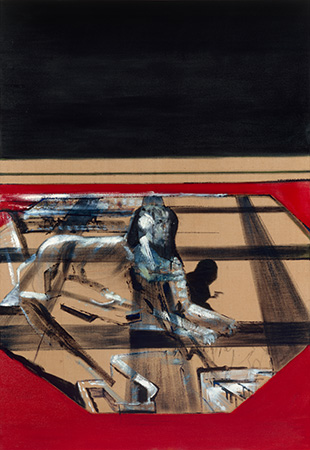 There are other influences from 'the entire history of Western painting' [ambitious project then]. Christianity subjected form or Figure to 'a fundamental deformation'. God was no longer a simple essence because he had been incarnated. This also introduced into Christianity 'the event, or even the changeable, the accident'. This makes even Christian painting familiar, so that the painter can be 'indifferent to the religious subject' and since God incarnates, he can be depicted as objects [a note, page 138, extends the idea that the beautiful must always contain something accidental as well, as a kind of original sin]. Man experiences himself as an accident, implying a fall, and the accident comes to dominate over the essence in painting [a legacy of the Egyptian notion that the form can indicate the essence, Deleuze says] Greek art had already distinguished planes, invented perspective and relief. The optical space here implies 'a distinct viewing that is never frontal' (87), with form and ground on different planes united by perspective. Objects can overlap. 'Light and shadow fill up space and make it rhythmic' [pass -- I'm still unclear about this term -- a systematic alternation of light and shadow?]. The contour now depicts just the form and makes the foreground primary. The accidental has been organized optically into a phenomenon, 'a "manifestation" of essence'. Painting has discovered its own aesthetic laws and work is both 'organic and organized, plastic'. Figuration is one result, where the form 'expresses the organic life of man as subject' [and as part of the organic world, a note on 138 suggests]. This optical space is no longer just haptic, although it still has tactile values, but is subordinated to vision: it is 'tactile–optical space' (88) expressing not essence 'but connection; that is the organic activity of man' [supported by a quote from Maldiney, who does a lot of work here]. The organic contour becomes a mould, helping to develop a perfect optical form. This does not vary by plays of shadow and light. It is an individuated form, operating 'through visual variations and diverse points of view'. There are associated with this 'an extraordinary set of properly pictorial inventions'. The way forward after this is either to develop still further a purely optical space no longer referred to tactility, or to 'the imposition of of violent manual space' reasserting the tactile — as in automatic writing. We find both in Byzantine and Gothic art. The claim becomes a background, and an 'active support of impalpable forms' depicted increasingly by light and shadows. Eventually, these 'rhythms of light and shadow' will develop even more autonomy for optical forms. The tactile is no longer relevant. 'Indistinct zones become essential', even when objects are depicted clearly, there is still some communication with shadow, darkness and the background 'and in a relationship that is specifically optical' religious sentiment changes as well, delivering a notion of 'spiritual assumption, a "grace" or "miracle"' (89). There is a notion of more autonomous composition. Essence and law is created, forms transformed or transfigured, from dark to light. There is a notion of disintegration in composition, as things ascend into the light, and this is the tradition that appears even in abstract painting — 'disintegrating factors… relations of value, of light and shadow, of clarity and obscurity… an optical code'. In the Barbarian or Gothic art organic representation gives way, but not to the purely optical, rather to the tactile — the vital and violent Northern line, characterized by speeds and changing direction, representing 'the most bizarre and intense kind of life, a non-organic vitality' (90) [this is based on Worringer}. The line is too complex to be a simple line and the plane is no longer a surface. Nor do contours outline things. The line can be composed of certain strokes — 'traits of the body or the head, traits of animality or humanity' which provide 'an intense realism', but in the sense of deformation not transformation. The line becomes indiscernible, common to different animals and also resulting from pure abstraction. The principle is 'an operative geometry of the trait or the accident' — the line constantly encounters obstacles or accidents, and must divert and sometimes intensify. We have a manual space with 'manual aggregates'. Sometimes the effect is to make 'the body exceed the organism', uniting separate organisms, independently of optical characteristics. The tendencies towards pure optical and pure manual spaces are not incompatible. Both challenge classical representation, and both discover 'new and complex combinations and correlations' (91) [a baffling example follows — realizing the potentials of light independently of forms means that curved forms can be 'decomposed into flat strokes that change direction, or even into strokes dispersed inside the mass' — referred to Wolfllin]. The source of accidents becomes unclear — the light or the manual line. Apparently, if we look at a Rembrandt upside down and close-up we will 'discover the manual line as the reverse of optical light' [Try it with the still life above?] Colour complicates matters. It seems to be purely optical and becomes increasingly independent of the form. Colour can depict additional relations: 'relations of value' based on contrast, whether 'tones are dark or light, saturated or rarefied'; 'relations of tonality' based on the spectrum and the opposition of colours, so that tones 'can be defined as warm or cool'[discussed further in a note on page 139]. These are constantly mixed and combined [examples pages 91 – 92]. We find in Cézanne local tones, shadows and lights, and then a 'sequence of tones in the order of the spectrum, a pure modulation of colour that tends to be self-sufficient' and a note on page 140 has a debate on whether Cézanne equated warm and cool with light and dark]. Nevertheless, relations of value tend to refer to the functions of distant vision, and modulations of colour 'recreate(s) a properly haptic function' where tones are arranged in progressions and regressions. Thus if relations of value dominate, we get predominantly optical spaces, and with relations of tonality we get more of 'haptic space'. The same colour [tones of grey in this case] will produce optical or haptic effects. The haptic is not optical nor tactile in the earlier senses. Warm and cool tones can even imply 'eccentric or concentric movement of expansion or contraction' and there are other oppositions as well. For example, optical spaces tend to deliver 'an intimacy' [a familiarity?]. There is also a danger of restoring narrative ['we represent what we think we can touch, but we narrate what we see, what seems to be happening in the light or what we presume is happening in the shadows' (93). Heading toward abstraction, such as 'a pure code of black-and-white' is one way to avoid this. Colourism offers a more analogical alternative — the mould it offers is also depicting modulation, 'a continuous creation of space, the spatializing energy of colour' [an equally baffling note on page 140 tries to describe the difference between moulding and modulation, with the latter as 'a continuous, temporal mould… A continuous and perpetually variable manner']. Thus colourism can avoid both narrative and conventional figuration, and move closer 'to the pure state of a pictorial "fact" which has nothing left to narrate'. This follows from the (re)constitution of the haptic function of sight. Egyptian values have appeared in these new forms. Chapter 15 Bacon's Path [Definitionally?] the work of [only] 'a great painter' (94) should be grasped as a form of 'historical recapitulation… stopping points and passages, which are extracted from or reconstitute an open sequence' [almost a specific description of a plane of consistency?] Thus Bacon has Egyptian elements, although there is no search for essence and 'humankind is an accident'. Background is separated from foreground not through classic perspective but through 'a "shallow" depth'. This appears to break the notion of the haptic world and inaugurate a tactical – optical world, but eventually, 'a pure optical world… tends to free itself' (95), and forms are severed from tactical connections. The dangers of figuration and narration re-emerge. Bacon proceeds to cut through the conventions of the tactical optical or pure optical worlds in the form of a manual diagram which overturns both optical and tactile connections. He also constantly tries to avoid the intimacy of homely depictions, associated with the conventional use of light and shadow [which is what I think D means by 'chiaroscuro']. Zones of indiscernibility are opposed to the optical and represent 'an unbridled manual power… a frenetic zone in which the hand is no longer guided by the eye… [appearing] as chance, accident, automatism or the involuntary'. The diagram is a point of relative rest amidst 'immense agitation' (96). It can therefore act 'as a relay', remaining localized and requiring something to emerge from it: 'the diagram always has effects that go beyond it'. It breaks with conventional optical relations but must still become 'reinjected into the visible whole', resulting in a haptic world, where the values of warm and cool colour indicate expansions and contractions. These colours do 'not depend on the diagram' but emerge from it. The colourists are painters who 'substitute relations of tonality relations of value', operating with 'pure relations of colour' to produce forms, shadows, lights and even time [definitionally demonstrated best in the 'masterpieces']. Colourists do use black and white, light and dark, but these are treated as colours and show tonal relations. In colourism proper, colour itself is the variable relation, 'on which everything else depends' (97). They push colour 'to its pure internal relations (hot – cold, expansion – contraction)' and everything else follows — 'Form and ground, light and shadow, bright and dark. Colour produces a particular kind of clarity, not tangible form or optical light but the relation between 'complementary colours' [a note on page 141 refers back to Cézanne's method: 'he saw modelling as a succession of colours progressing from warm to cool. His great interest lay in determining each of the colours exactly… [allowing] him to observe oppositions down to half tones'. Van Gogh by contrast experimented with 'broken tones where complementary colours are mixed in unequal proportions producing 'a variety of grey', and this can be contrasted to new complementary colours']. A particular kind of sense is produced — 'a haptic site of colour-space as opposed to the optical sight of light–time'. [Then a brief aside about the differences between Newton and Goethe]. The 'practical rules of colourism are… The abandonment of local tone; the juxtaposition of un-blended touches; the aspiration of each colour to totality by appealing to its complementary colour; the contrasting of colours;… the prohibition of mixtures except to obtain a "broken" tone; the juxtaposition of two complementary or similar colours, one which is broken and the other pure; the production of light and even time through the unlimited activity of colour; the production of clarity through colour' [referred back to Gowing on Cézanne]. A masterpiece combines different tendencies — '(linear–tactile, luminist, colourist)', sometimes differentiating and opposing them. Colourism gives a haptic sense back to sight, and uses terms like '"touch", "vividness", "seizing hold of life", "achieving clarity"'. Cézanne risked reproducing a code with his reliance on the order of the spectrum. There were two additional 'demands' [from whom exactly? Gowing again], for 'a homogeneous ground and an aerial armature, perpendicular to the chromatic progression'; 'the demand for a singular or specific form which the size of the colour patches seem to put in question'. The problem arose with attempting to create 'large sections of homogeneous colour' to act as fields, while experimenting with forms [citing a certain G Duthuit], apparently combining 'a "unity of vision" and a singularised perception' (98) [then a learned discussion about the differences between Cézanne and Gauguin on the use of colour, and a quote from van Gogh admitting to being an arbitrary colourist]. Apparently, uniform patches of colour imply 'a passage or tendency with very fine differences of saturation', while the volume of the form uses broken tones, but this is 'another type of passage in which the colour seems to have been fired and baked in a kiln'. These are additional modulations. This is rediscovered when we move from landscapes to portraits, because 'the flesh calls for broken tones' (99), and the trick is to make these tones resonate with uniform flat fields. Bacon recognized the properties of flesh and its colour and used broken tones to produce the body, while bright tones produced the armature or the field. The whole problem lies in relating these two. In Bacon, vivid colours act as shores and broken colours as flows. Time itself is depicted in the chromatic variation of broken tones and as eternity in the monochrome of the fields. This is still dangerous if the broken tones of the Figure of blend and lose their clarity [an interesting note on page 142 says that Bacon prefers oils to acrylics because the latter are more predictable]. This tendency can be found in Gauguin and also in Bacon's malerisch period [although Deleuze insists that for Bacon, dark curtains and the like should be seen as separating two planes, foreground and background, and this preserves clarity, at least 'in principle']. Bacon saw the danger himself and moved to depict the shallow depth separating the planes in a more haptic space. Chapter 16 Note on Colour. The three fundamental elements were the armature, the Figure, and the contour. There are other contours in some of the paintings that seem to 'belong to' (101) the armature or the figure, sometimes even suggesting a mould. Deleuze prefers to think that the contour relates to 'different modalities of colour' and points in particular to a third element, not a volume but a line — things like the round areas, puddles, even the armchair. They are all about colour and its modulation, relations between colours. The Figure at a Washbasin (below, has been analyzed by a certain M Le Bot (102) which refers to rivers of colour blocked by reefs which confine and fix, 'broad flows of colour' which result in 'a dynamic that makes the gaze glide from the bright ochre to the red'. [This work is also the only one I can find that mentions the directional arrow, fairly common in the paintings but unremarked by Deleuze except here: the arrow shows the direction of gaze]. For Deleuze, the ochre is a background shore, while the contour is 'an autonomous power', the crimson on which the Figure is standing. The Figure itself is, as before, a flow of broken tones. However there are also 'secondary yet indispensable elements'. One is the wash basin which cuts across the field as 'a second autonomous contour' surrounding the head. Another is the pipe which divides the field of colour in half. Then the blind occupying the shallow depth between the field and the figure, making the entire painting relate 'to one and the same plane'. The broken tones in the Figure incorporate the tones of the field and also of the cushion and wash basin: 'It is a rich communication of colours'. 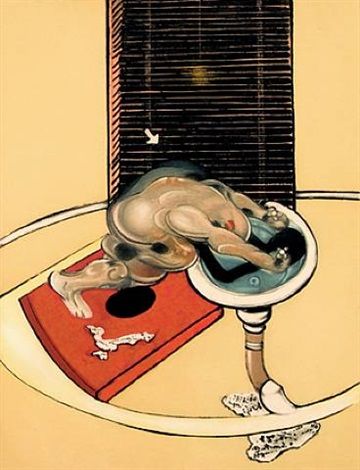 Then we have to distinguish 'the mode of the shore or the field' and its relation to the armature. In the tryptitches we often see fields of monochrome colours, as in the Three Studies for Figures at a Crucifixion (below). The relations between the colours are not just those of value, not just varying in intensity or saturation, according to proximity to particular zones [presumably front and back, for example, or lit and shaded]. Proximity is depicted in several ways, however: sometimes with 'clear-cut sections of another intensity or even another colour' (103); sometimes by limiting or containing the field by another contour taking up a section of the painting. Here, this contour 'still belongs to the field' because it is less 'concise' than other contours [the orange and red sections in 3 Studies again, especially on the left panel?]. On other occasions the field is interrupted by a thin bar [including in Washbasin above] or by another band of colour. 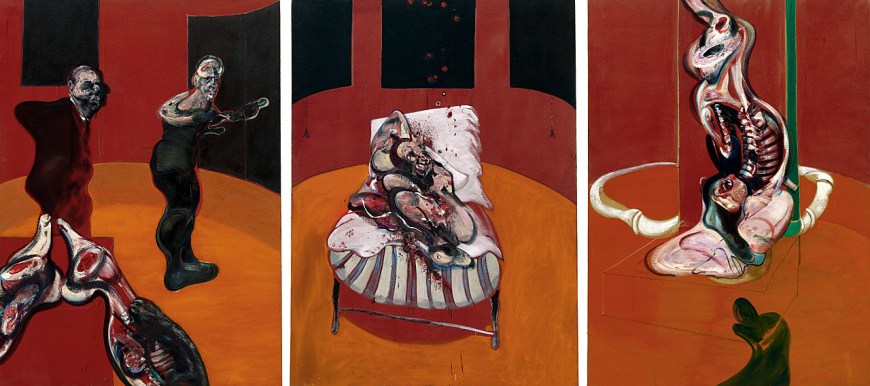 In the 'purest pictorial situation', the field is not sectioned or limited but covers the entire painting. Other contours are encompassed. These are 'truly aerial' and depict 'a maximum of light like the eternity of a monochrome time, "Chronochromie."'' (104) [also the title of 'a work by Oliver Messiaen incorporating 18 bird songs' we are told in a note on page 143]. Sometimes, the field itself can display 'subtle internal variations that depend on relations of proximity' (104), sometimes shown where a ribbon crosses a field. The effect is to produce 'a kind of temporal or successive perception of the field itself'. Generally, though, the smaller and more localised the contour, 'the more aerial the triptych will be' [the 1970 Triptych below is the example — 'the blue circle and the ochre apparatuses seem to be suspended in a sky'. There is also a temporal perception — time is eternity. 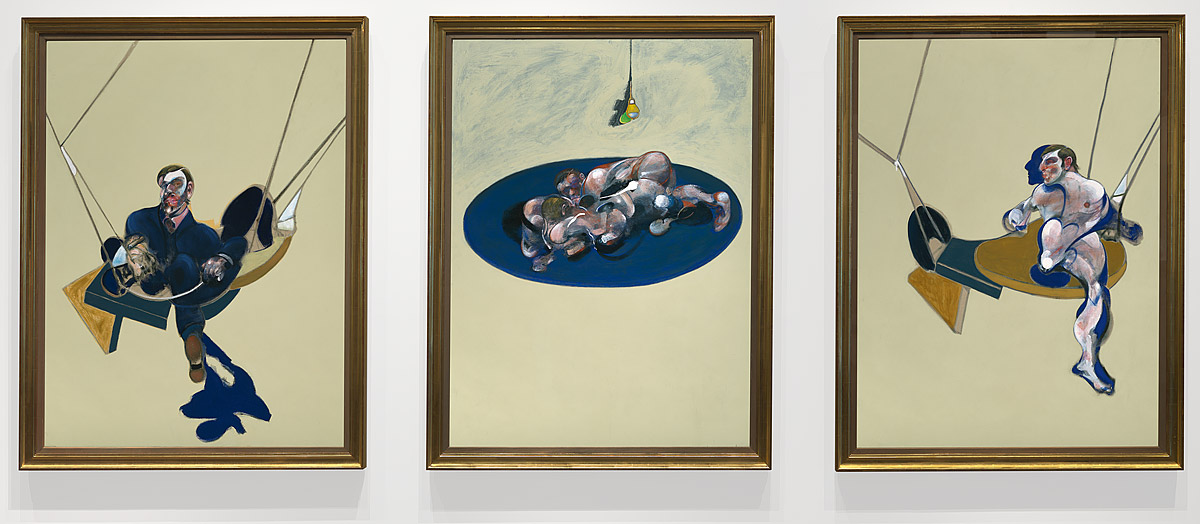 Overall, a uniform field of colour can provide a structure by displaying different zones of proximity with contours. The armature is something connected with both field and horizontal plane defined by a large contour 'which implies an active presence of the shallow depth' or 'the system of linear apparatuses' that deny all depth [the 1970 Tryptitch again]. There are other devices, where particular sections can sometimes include a localised black section [although, bafflingly, this can also be 'total or constituting the entire field — Three Studies for the Human Body above]. The black section does the same as the curtains, making 'the field of colour project itself forward', filling the shallow depth. Other examples show black sections retreating from the field — no problem for Deleuze because it merely shows 'that Bacon did not reach this new formula for black all at once'. When we look at Figures, we see flows of colour, often as broken tones constituting flesh [with one exception, apparently]. This sets up an opposition to monochrome shores with its vivid and pure flat colour. In polychromatic colours blues and reds feature — 'precisely the dominant tones of meat' — in bodies and heads. [One example is the portrait of Miss Muriel Belcher, below]. 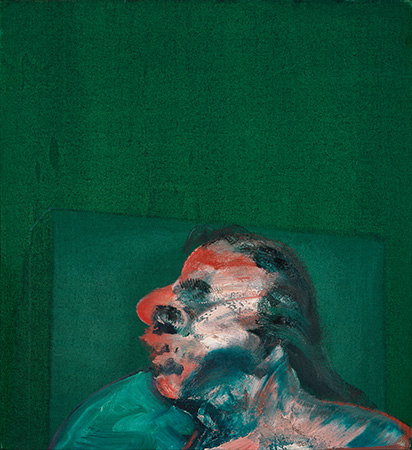 Other aspects of the Figure, like clothes or shadows might preserve conventional values of light and dark, 'a completely different regime' (105). There is a regime that traces minute variations in the body 'as the content of time' to contrast with the eternity depicted by the shores or fields, but there is also a place where 'colour–structure gives way to colour–force', where each colour shows the exercise of a force on a body or head; 'it immediately renders a force visible'. Although variations in the the field can hint at proximity, colours themselves indicate proximity but on the diagram, 'as the point of application or agitated locus of all forces'. This can still be spatial, but it is also 'topological', acting at a distance, possibly located elsewhere than the head. The contour can include other contours, and here colour retains a more conventional 'tactile–optical function', connected to the function of the closed line, for example when contours appear at an angle, indicating horizontal planes separate from the vertical. Yet this is a 'subordination to the line in appearance only' (106). Contours are autonomous elements, so the line can be determined by colour: it 'creates the line and the contour'. Sometimes, contours appear as decoration, when they are 'treated as rugs' for example. Small contours can seem to celebrate colour in itself, rather like 'the halos of premodern painting': as with halos, we have 'a coloured pressure that ensures the Figure's balance and makes one regime of colour pass into another'. So colour does not just relate warm cool, expanding and contracting. There are whole 'regimes of colours' which can be related, as in the harmony between pure and broken tones. This also develops 'haptic vision', as a kind of totality including all the other three elements and making them 'communicate and converge in colour'. Is this just down to 'superior "good taste"' as somebody called Fried evidently thought? Did Bacon learn his trade as a decorator? There is 'good taste' displayed in the armature and the fields, but also bits of bad taste, anti-decoration, as with elements that make the Figures into monsters, or when rugs have 'a particularly ugly pattern' [a comment suggests Bacon sought out particularly hideous ones]. Even so, these effects only indicate 'a lingering figuration'. We can see them instead as 'the most natural of poses, in accordance with the everyday task that occupies them in the momentary forces that are confronting them', or when we consider rugs '"figurally"' [that is according to the interest in the Figure not the figuration?]. Here, hideous rugs serve to 'decompose the vertical field' [the example is Man and Child above] and help us move from the field of violet to the broken tones of the Figure, once we see them as colour contours. This indicates 'a creative taste in colour, in the different regimes of colour, which constitute a properly visual sense of touch, or a haptic sense of sight' (107). Chapter 17 The Eye and the Hand It is not just that eyes judge and hands execute. There might be 'dynamic tensions, logical reversals, and organic exchanges and substitutions' (108). Sometimes the hand can be subordinated by paintbrush and easel, but the paintbrush is never satisfactory. Hands can offer several 'values… The digital, the tactile, the manual proper, and the haptic'. The digital subordinates the hand to the eye and all the hand does is to choose units that correspond to visual forms: the eye dominates the work producing an '"ideal" optical space' and optical code. However, there are still manual referents at the virtual level — 'depth, contour, relief, and so on, tactile referents'. If this is relaxed subordination, 'a veritable insubordination of the hand' is also possible, imposing on sight 'a space without form and movement without rest'. This 'dismantles the optical'. This is what Deleuze meant by referring to the manual aspects. The haptic does not permit dominance of either eye or hand, but rather discovers 'a specific function of touch', (109) not subordinated to the optical or tactile [a note on page 143 reminds us that 'haptic' is Reigl's term]. As we saw, it developed first in Egyptian art. Developing it in a modern context requires 'violence and manual insubordination'. Conventional figuration is 'rather like the consequence of [tactile–optical] space'. It is always there, if only virtually or in 'the head of the painter', Bacon argued. This space is to be disrupted through 'a catastrophe… the manual "diagram"', made of 'insubordinate colour patches and traits'. Even if we start with the figurative form, a diagram can intervene 'and scrambles it' and something completely different emerges — 'the Figure'. Examples include the 1946 Painting above, [I repeat it below] which began by Bacon wanting to paint a bird alighting on a field. But the lines 'suddenly took on a kind of independence and suggested "something totally different," the man under the umbrella'. The portraits might include some organic resemblance, but also something 'more profound… in which the organs… can no longer be discerned'. This follows from '"the paint moving from one contour into another"' [quoting Bacon's interviews]. This shows that the diagram is far from being a coded formula.  It is not just that we pass from one form to another, from bird to umbrella, because in the portraits there is only a single form. Referring back to the 1946 Painting, Bacon himself says that the bird existed first in the intention of the painter, but this eventually gave way to a whole, not only the painting, but 'to the umbrella series' (110). We can see the diagram still in the 'scrambled zone, below and to the left' [the confused colours n the 'rug'?] and it communicates 'through the black shore'. If the bird is an intentional figurative element, it develops a correspondence or analogy not to the umbrella form, itself still figurative, but to 'the series or the figural whole': that is the 'specifically aesthetic analogy' — the arms of the meat are analogues to wings, but there are sections of the umbrella which refer to falling or closing. Far from a simple analogy, there are 'completely different relations, which create a complete Figure'. The diagram ['diagram–accident'] is not transformed but it scrambles the intentional figure of the bird by adding 'non-formal colour patches and traits that function only as traits of birdness, of animality'. These are nonfigurative and it is from then that the 'final whole emerges' and from which the 'power of the pure Figure' appears. The diagram imposes indiscernibility between the two forms — one 'no longer, and the other, not yet'. It stops the second form becoming a conventional figure. Between the two 'it imposes the Figure'. The form has been deformed, subjected to 'original relations which are substituted for the form' — meat flows, the umbrella seizes, the mouth is made jagged like a beak. So 'formless forces' are introduced and distributed, located on the deformed parts. So everything is done inside the same form. We might start with an intentional figurative head, but then scramble it 'from one contour to the other'. (111).This is often done by 'the coloured grey' which permits new relations to appear, the broken tones, a break with resemblance. However, there is 'a more profound resemblance, a nonfigurative resemblance — that is a uniquely figural Image'. We have produced resemblance 'with non-resembling means'. Bacon expresses the general formula in a number of ways, lines as well as colours, traits as well as patches, a notion of distance. So figurative lines can be scrambled by extending or hatching them, new distances, new relations between, as when the mouth goes right across the face [in one of Bacon's own examples] [with a repetition of the example about including the distances of the Sahara in a portrait]. The diagram must remain localised, not cover the entire painting, not create a catastrophe or scramble the whole thing. It is intended to break tones rather than mix colours. It is a manual element which is 'reinjected into the visual whole'. It has consequences which are emergent, and if nothing emerges, it fails. The Figure emerges 'both gradually and all at once' [! The example again is the 1946 Painting — apparently, the whole is given at once, while the series is constructing gradually, which makes far more sense]. We also take different perspectives, as we note 'the heterogeneity of the manual diagram and the visual whole', a shift first from optical eye to hand, and then from the hand to the eye. We can also see these shifts as a process instead, 'a "slow leak,"' (112) [presumably quoting Bacon himself]. In this process, we move from 'hand to haptic eye', from 'manual diagram to haptic vision'. This is 'the great moment in the act of painting' because it is painting's solution to 'the problem of a pure logic: how to pass from the possibility of fact to the fact itself' [Bacon's terms again apparently, but a note on page 44 notes an analogy to Wittgenstein]. The diagram is the possibility of fact, but the painting presents a particular fact — 'the pictorial fact'. This implies that there are several forms in the one and same Figure, 'like so many necessary accidents continually mounting on top of one another' [citing Bacon again]. This quality overcomes the limits of the figurative and the narrative: the pictorial fact no longer tells a story, and represents only 'its own movement'. Apparently arbitrary elements appear as 'a single continuous flow [Michelangelo was one of the first to depict the pictorial fact instead of a narrative religious fact, we are told in a note on page 144]. Organic resemblances may remain, but something is also revealed — 'the revelation of the body beneath the organism, which makes organisms and their elements crack or swell, imposes a spasm on them, and puts them into relations with forces' both internal and external, sometimes via specific time, and sometimes via eternal time. The bodies in Bacon are not to be understood through narratives of suffering — these are natural postures 'as if we caught them "between" two stories'. The pictorial fact needs no other justification. Everything is now made clear. The activity of painting in Bacon 'evoke this direct manual activity that traces the possibility of fact' (113). This pictorial fact may have come from the hand, but it can also be seen as 'the formation of a third eye, haptic eye, haptic vision of the eye' which offers a new clarity, surpassing 'the duality of tactile and optical'. It is 'born of the diagram'. back to Deleuze page |